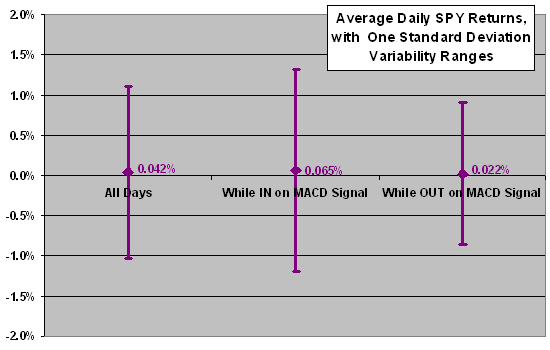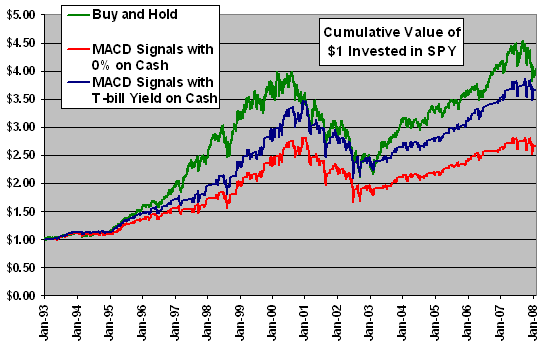Here is a simple test of the Moving Average Convergence/Divergence (MACD), as calculated using the Exponential Moving Average (EMA) template at StockCharts.com, on a tradable proxy for the S&P 500 index. MACD is the difference between the 26-day EMA price and the 12-day EMA price for an asset. A bullish (bearish) crossover occurs when MACD moves above (below) its 9-day EMA. To reduce the number of very short-term MACD trades, we filter out “close calls” by requiring MACD to reach a level 25% above or below its 9-day EMA before triggering a trade. Using daily dividend-adjusted closing prices for the S&P Depository Receipts Trust (SPY) from 1/29/93 (the earliest available) through 2/29/08, we find that:
We apply the MACD calculations and thresholds as follows:
- Calculate MACD over the sample period.
- Calculate the 9-day EMA for MACD, along with thresholds plus and minus 0.25 times the absolute value of the 9-day EMA, over the sample period.
- The first time there is a new MACD buy signal (MACD rises at least 25% above its 9-day EMA), buy SPY at the close.
- The first time there is subsequently a MACD sell signal (MACD falls at least 25% below its 9-day EMA), sell SPY at the close.
- Repeat the previous two steps across the entire sample.
- Whenever out of SPY, assume a daily return on cash equal to the contemporaneous 90-day Treasury bill (T-bill) yield.
- Ignore trading fees/frictions (since there are on average only a handful of transactions per year).
This approach generates 168 MACD-triggered transactions (84 round trips) over the entire sample period, an average of about six round trips per year. Of the 3,799 trading days in the sample, these transactions put the portfolio in SPY 1,708 days (45%) and out of SPY 2,091 days (55%). The 84 round trips produce 62 gains (with the largest 19.2% in mid-1995) and only 22 losses (with the largest -12.5% in mid-2002). The average gain for all 84 round-trip trades is 1.3%.
The following chart summarizes the average daily SPY returns for all days in the sample, days when in the market on MACD signals and days when out of the market on MACD signals. It shows that daily SPY returns tend to be above normal between MACD buy and sell signals and below normal between MACD sell and buy signals. It also shows that daily return volatility tends to be relatively high when in the market.
Do these results make the MACD trading strategy a market-beater?

The next chart plots the cumulative value of $1 initial investments made at the close on 1/29/93 in three strategies:
- Buy and hold SPY
- Trade in and out of SPY on MACD buy and sell signals, with no return while out of stocks
- Trade in and out of SPY on MACD buy and sell signals, with return on cash while out of stocks equal to the contemporaneous daily T-bill yield
The chart shows that the MACD strategies underperform buy-and-hold over the sample because: (1) they are often out of stocks; and, (2) even the low return on SPY while the MACD strategies are out of stocks slightly beats the T-bill yield. Visual inspection suggests that the MACD strategies tend to underperform (outperform) buy-and-hold during bull (bear) market phases, lending them some appeal on an annual risk-adjusted basis. Results are sensitive to the start date of the analysis.
Are there better ways to exploit MACD signals?

Some ideas for exploiting MACD signaling are:
Apply leverage on buy signals to exploit the abnormally high average returns during such intervals. However, leverage is not free, and the relatively high daily volatility during these intervals may make leverage painful. Also, unleveraged buy-and-hold may not be the appropriate benchmark for leveraged strategies.
Combine MACD on SPY with MACD on other assets/asset classes to generate a better return than the T-bill yield when out of SPY. Different assets/asset classes may be sufficiently “out-of-synch” with the broad U.S. stock market to support this approach, but capital may not be available for the portfolio to respond crisply to all MACD signals as generated.
Reduce the number of days out of stocks by loosening the MACD buy signal threshold, but not the sell signal threshold. For example, removing the filter for buy signals but keeping the 25% filter for sell signals: (1) puts the MACD strategies in stocks about 62% of the time; and, (2) makes the cumulative return for the MACD strategy with T-bill yield on cash about equal to that of the buy-and-hold strategy (again ignoring transactions fees/trading frictions). For this alternative approach, the average daily return while in (out of) the market on MACD signals is 0.056% (0.019%).
In summary, a broad index trading strategy based solely on MACD crossovers probably has difficulty keeping up with buy-and-hold over long periods, but MACD crossover signals might be useful within more complex strategies.